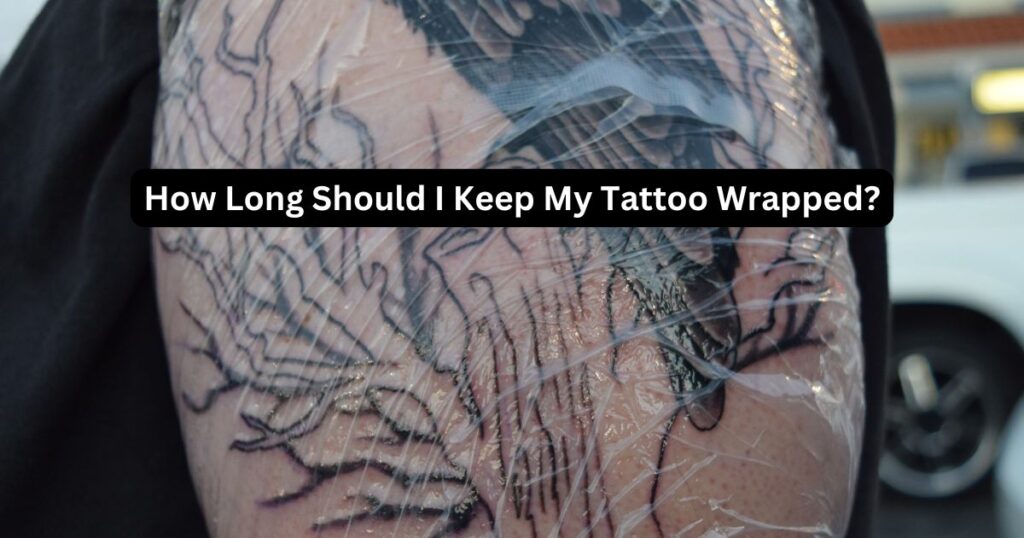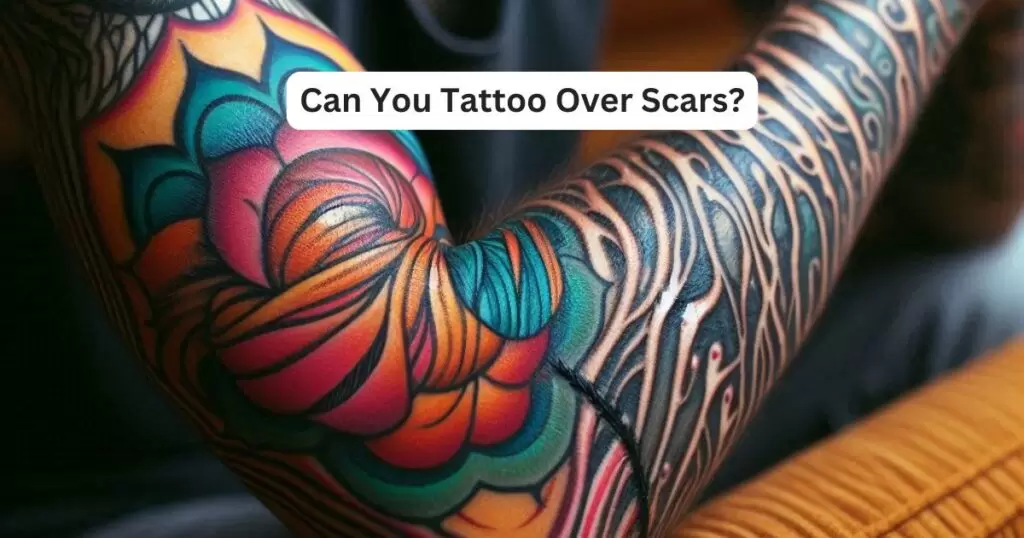When you first get a tattoo, you should keep it wrapped for a few hours, typically between two to four hours. This initial wrapping is crucial as it protects your fresh tattoo from bacteria and helps prevent infection.
After this time, you’ll need to remove the wrapping to allow your tattoo to start healing. However, understanding when to rewrap your tattoo, or if you should, depends on several factors.
Why Wrapping Your Tattoo Matters
Your tattoo is essentially an open wound. During the first few hours after getting inked, your skin is highly susceptible to infection. Wrapping your tattoo creates a barrier between your skin and potential contaminants like dirt, bacteria, and other environmental hazards.
The initial wrap also absorbs any blood, ink, or plasma that leaks from the tattoo, preventing these fluids from drying on your skin and forming hard scabs.
The First Unwrapping: What to Do
After two to four hours, it’s time to remove the initial wrap. Clean your hands thoroughly before touching your tattoo. Carefully peel away the wrap and wash your tattoo with lukewarm water and a mild, fragrance-free soap.
Avoid scrubbing; instead, gently pat the area with your fingers to remove any ointment, blood, or ink residue. After washing, pat the tattoo dry with a clean, soft towel. Do not rewrap your tattoo immediately after this first cleaning unless advised by your tattoo artist.
Rewrapping Your Tattoo: When It’s Necessary
In most cases, your tattoo doesn’t need to be rewrapped after the initial removal. However, certain situations may require you to rewrap it for a short period. For example:
- Overnight Protection: If you notice that your tattoo is sticking to your bedding or clothing, you may want to wrap it overnight for the first few nights. Use a clean, non-stick wrap, such as plastic wrap, to cover the tattoo. This will prevent friction and keep bacteria from transferring to your tattoo while you sleep.
- Physical Activity: If your daily routine involves physical activities that cause excessive sweating or friction, consider rewrapping your tattoo during these periods. Activities like running, cycling, or lifting weights can irritate your tattoo and increase the risk of infection. In these cases, rewrap your tattoo with a breathable bandage or plastic wrap, and remove it as soon as you’re done with the activity.
- Dirty Environments: If you work in a dirty or dusty environment, rewrapping your tattoo can provide added protection. This includes jobs in construction, gardening, or any setting where your tattoo might be exposed to harmful substances. Again, use a clean wrap and remove it as soon as you’re out of the risky environment.
How Long to Keep Your Tattoo Wrapped: Special Cases
While the general advice is to keep your tattoo wrapped for just a few hours, there are special cases where you may need to extend this period:
- Saniderm or Other Protective Films: Some tattoo artists apply a special adhesive film, such as Saniderm, over your tattoo. This film acts as a second skin and is designed to stay on for several days, typically three to six. The film allows your tattoo to breathe while protecting it from bacteria, reducing the need for rewrapping. If your artist uses Saniderm or a similar product, follow their specific instructions for care and removal.
- Large Tattoos: If you have a large or complex tattoo that covers a significant portion of your body, your artist may recommend keeping it wrapped for a longer period. This helps manage the increased amount of plasma, ink, and blood that might ooze from the tattoo during the first few hours. Always follow your artist’s advice for these situations.
Risks of Keeping Your Tattoo Wrapped Too Long
While wrapping your tattoo can offer protection, keeping it wrapped for too long can cause problems. Prolonged wrapping can create a moist environment that encourages bacterial growth. This can lead to infections or slow down the healing process.
Additionally, the wrap can trap sweat and dirt against your tattoo, leading to irritation and delayed healing.
When to Leave Your Tattoo Unwrapped
After the initial wrapping period, it’s generally best to leave your tattoo unwrapped. Allowing your tattoo to breathe is crucial for proper healing.
Fresh air helps the skin to dry out naturally, reducing the risk of excessive scabbing and scarring. You should only rewrap your tattoo if necessary, as discussed earlier, and remove the wrap as soon as possible.
Signs You Should Stop Wrapping Your Tattoo
If you notice any of the following signs, stop wrapping your tattoo and consult your tattoo artist or a healthcare professional:
- Excessive Redness or Swelling: Some redness and swelling are normal, but if it persists or worsens, it could be a sign of infection or irritation caused by the wrap.
- Unusual Pain or Heat: If your tattooed area feels unusually hot or painful, this could indicate an infection. Wrapping it further could exacerbate the issue.
- Prolonged Moisture: If your tattoo stays wet or sticky for an extended period after rewrapping, this could slow the healing process. The skin needs to dry out slightly to heal properly.
Tattoo Aftercare Beyond Wrapping
Proper tattoo aftercare goes beyond the initial wrapping period. Here are some general tips to ensure your tattoo heals well:
- Keep It Clean: Wash your tattoo gently twice a day with mild, fragrance-free soap and lukewarm water. Avoid scrubbing, and pat the area dry with a clean towel.
- Moisturize: After cleaning, apply a thin layer of a recommended tattoo aftercare ointment or fragrance-free moisturizer. This keeps the skin hydrated and prevents it from drying out or cracking.
- Avoid Direct Sunlight: Sun exposure can damage your tattoo, especially during the healing process. Keep your tattoo covered or apply a high-SPF sunscreen once it’s fully healed.
- Don’t Pick or Scratch: As your tattoo heals, it will likely scab and become itchy. Resist the urge to pick at the scabs or scratch the area, as this can lead to scarring and uneven healing.
- Stay Hydrated: Drinking plenty of water helps keep your skin healthy and speeds up the healing process.
What to Expect as Your Tattoo Heals
Healing times vary depending on the size and location of your tattoo, but most tattoos take two to three weeks to heal on the surface. During this time, you may notice some peeling, scabbing, and itching.
These are all normal parts of the healing process. The deeper layers of your skin can take up to six months to fully heal, so continue to care for your tattoo even after it appears healed on the surface.
Common Myths About Tattoo Wrapping
Several myths surround tattoo aftercare, particularly about wrapping. Let’s debunk a few of them:
- Myth: Wrapping your tattoo speeds up healing.
Wrapping protects your tattoo in the early stages, but prolonged wrapping can slow healing by trapping moisture and bacteria against your skin. - Myth: Rewrapping your tattoo every few hours is necessary.
Constant rewrapping isn’t recommended. Your tattoo needs air to heal properly. Only rewrap when necessary, such as during physical activity or in dirty environments. - Myth: You should wrap your tattoo for the first three days.
This advice is outdated. Most tattoos only need to be wrapped for the first few hours after being inked. After that, keeping your tattoo clean and moisturized is more important than keeping it wrapped.
Listen to Your Artist
In summary, you should keep your tattoo wrapped for the first two to four hours after getting it done. After that, let it breathe unless specific circumstances call for rewrapping.
However, while general guidelines can help, your tattoo artist’s advice should always take precedence. They understand the specific needs of your tattoo based on its size, location, and your skin type. If they recommend a different wrapping schedule, follow their instructions.




